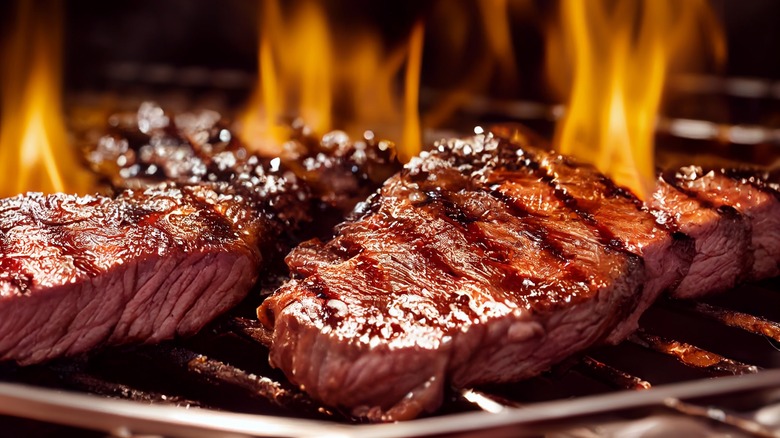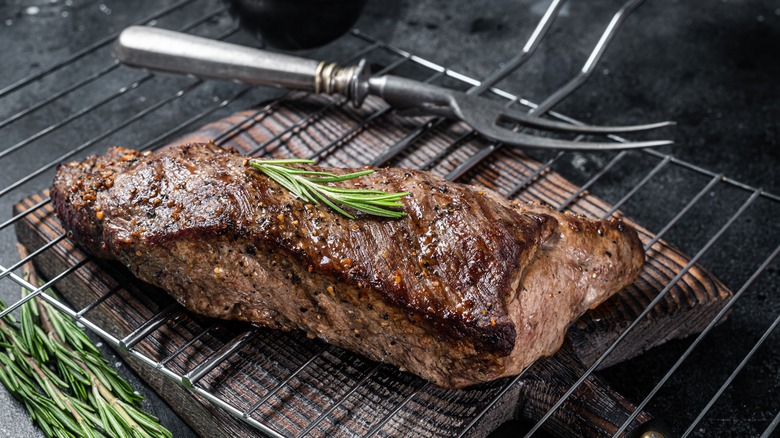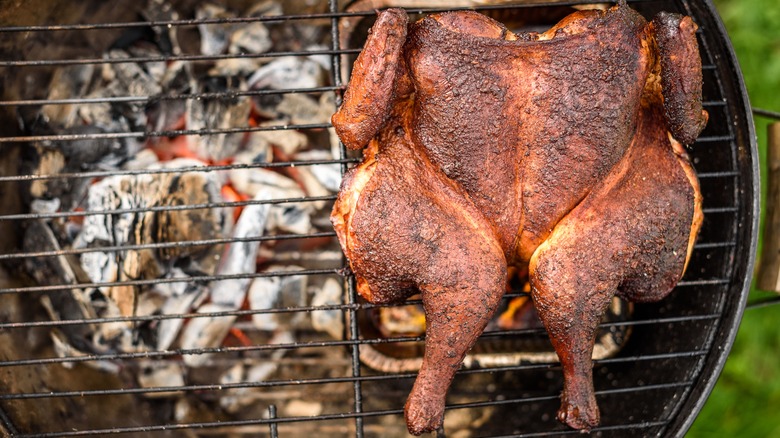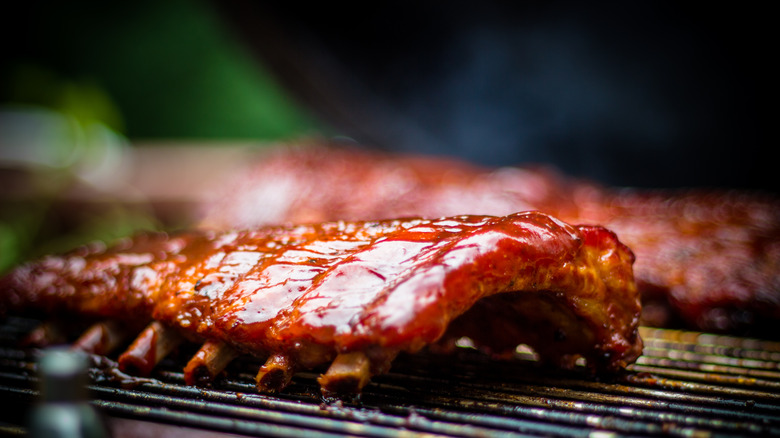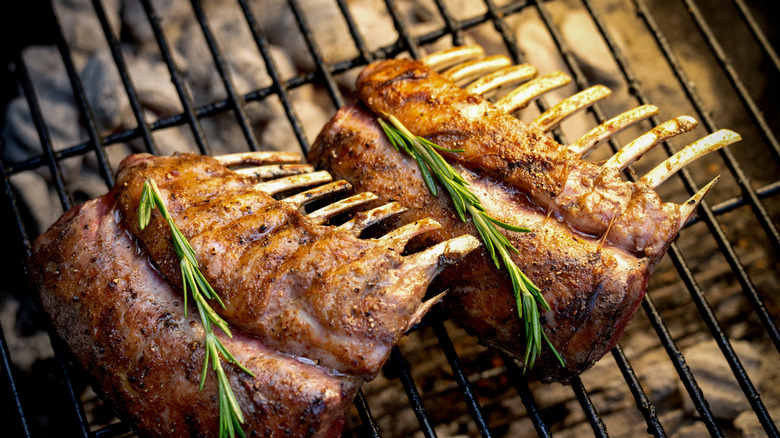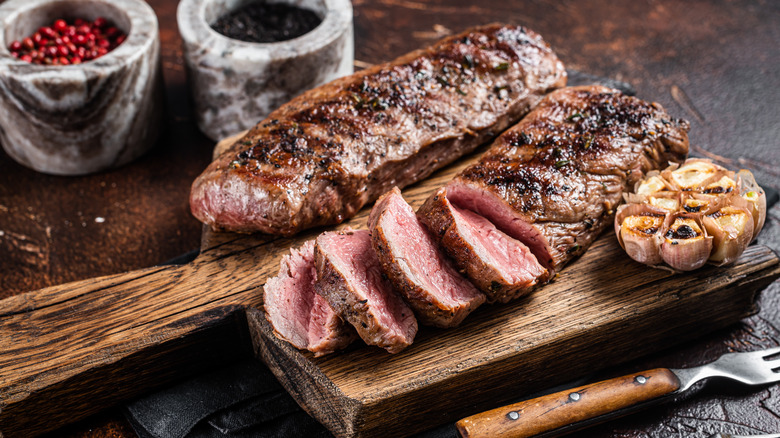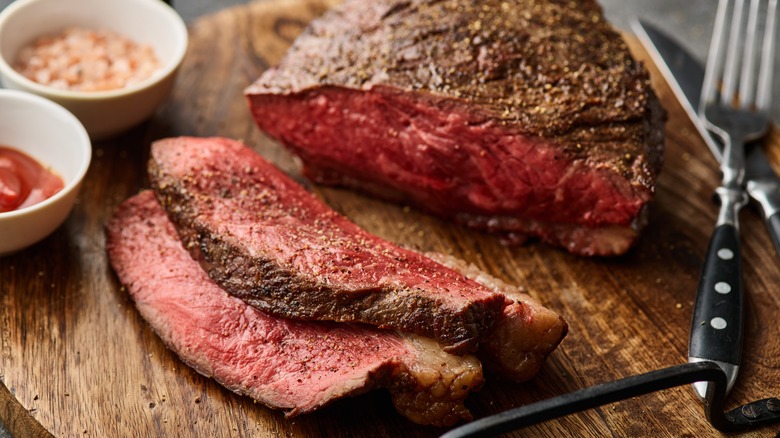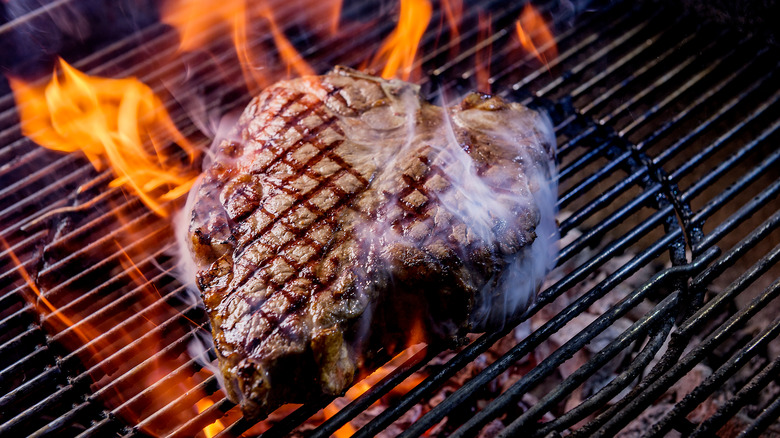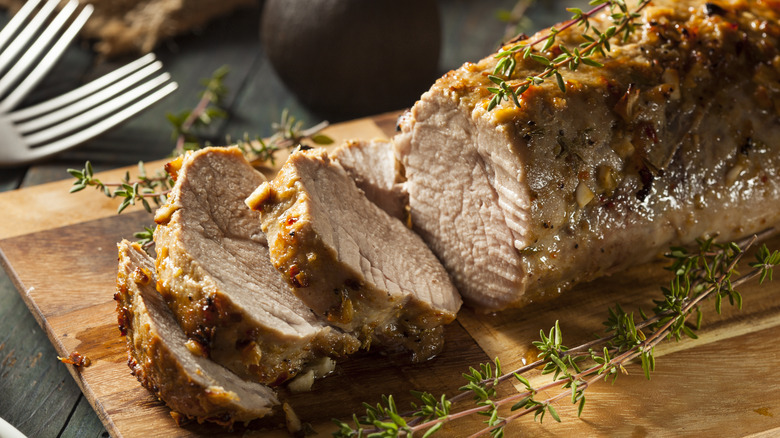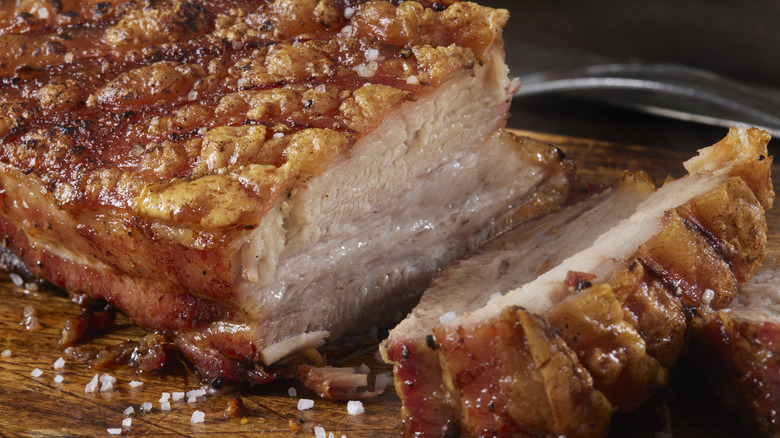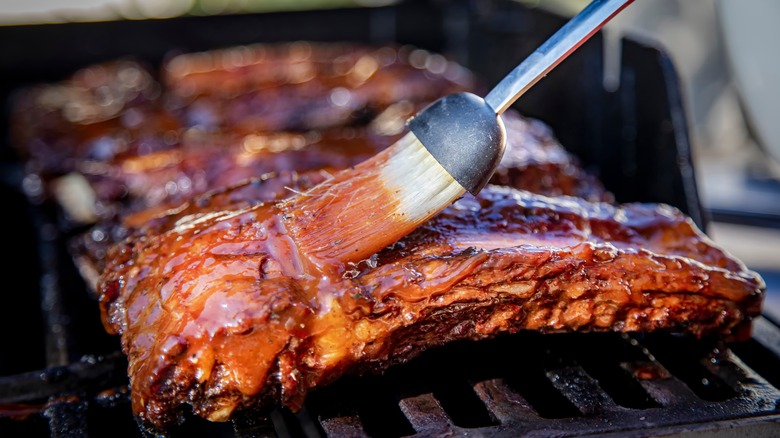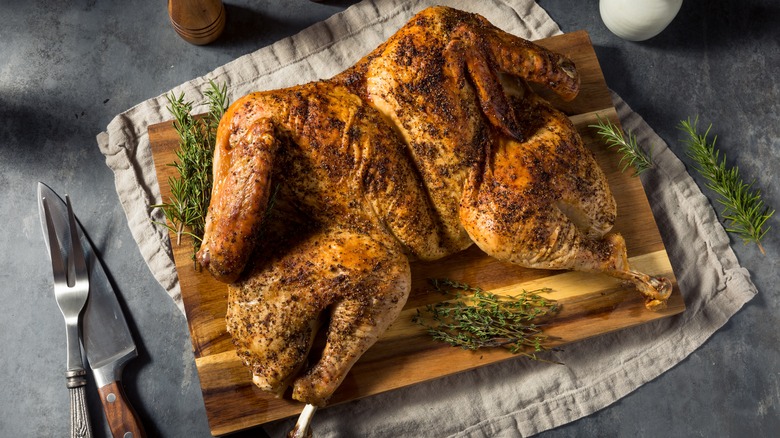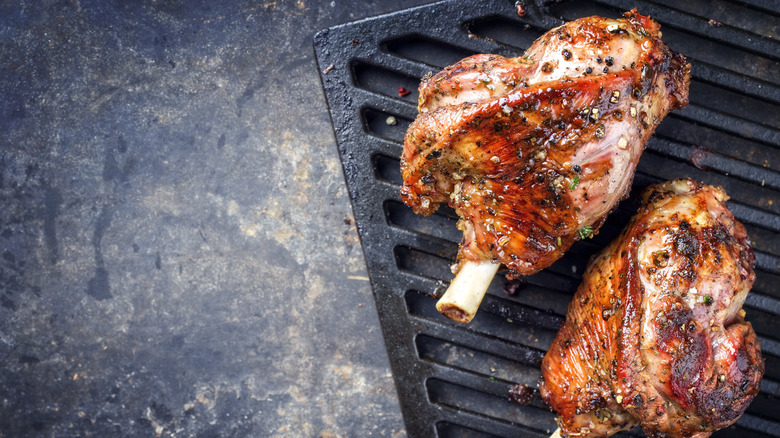12 Best Large Cuts Of Meat For Grilling
It's still high grill season as summer days continue to heat up and fall football tailgates loom on the horizon. As your backyard fills with friends and family, don't dread flipping endless burgers and sausages. Upgrade your grill game and feed a crowd with ease by grilling up an extra-large piece of protein.
When it comes to large cuts of meat, your first instinct might be to head for the oven. But with sweltering summer temperatures hitting record highs, it's probably best to avoid heating up your house and head for the grill instead. The best part about grilling is that you don't have to be an expert to produce a perfectly fall-off-your-fork-tender product. All it takes is a few grilling tips and tricks to go from pupil to pitmaster.
Whether you've got a gas grill or a traditional charcoal model, the key to grilling up large cuts of meat is to create heat zones under your grates. Keep one side of your grill hot for searing and the other a little cooler for long, slow roasting. The combination of heat zones allows you to better control the temperature of your meat, ensuring a lightly charred exterior and a juicy, moist middle.
Sure, it may take a little extra time to grill up a hefty porterhouse or rack of baby back ribs, but this investment promises delicious returns. Get ready to fire up the grill for these large cuts of meat prime for the pit.
Tri-tip
A regional roast popular on the California grill scene, tri-tip makes for an impressive upgrade to your next backyard barbecue. Weighing in at an average of two pounds, the bottom sirloin-cut tri-tip roast is an ideal cut for a crowd thanks to its affordability and fairly quick cooking time.
Due to its growing popularity, you'll likely be able to find a whole tri-tip roast at your local butcher or grocery store. Though, to be safe, you may want to call ahead — there's only one roast per cow, and it's often sliced into steaks or cubed into stew meat.
The best way to grill up your tri-tip is with a long hot sear (about 6 to 7 minutes) followed by a slow roast. First, you'll want to set up your heat zones so you can quickly transfer the steak from the searing stage to its cooler resting place. The second tip is to flip the beef every few minutes until it reaches the desired doneness. This frequent movement guarantees even cooking all the way through the roughly two-inch cut. Finally, be sure to let the meat rest for 10 to 15 minutes to avoid a tough final product.
All in, the triangular roast cooks for less than half an hour, leaving you plenty of time to enjoy the fruits of your labor. While it's unlikely that you'll have leftovers, the remnants can be sliced thin for roast beef sandwiches or tossed straight from the fridge on top of a light summer salad.
Whole chicken
Save time (and money) when grilling up your next batch of chicken by sticking with the whole bird. While it may be tempting to reach for familiar packs of thighs, breasts, and legs at the grocery store, keep in mind the additional labor cost attached to the pre-butchered birds and reach instead for a plump whole specimen.
The secret to making the best whole grilled chicken without drying it out is to utilize the tried-and-true spatchcock method. While you can certainly ask the butcher to prepare the chicken for you, spatchcocking at home is a fairly simple procedure. All you have to do is grab a pair of kitchen shears and cut down both sides of the backbone to remove and save it for another application, like chicken stock. Press down on the spineless bird to flatten it out, and voila! A perfectly spatchcocked chicken is prepped for the grill.
Keep your grilled chicken simple with just a coating of olive oil, salt, and pepper, or opt for an overnight soak in a citrusy marinade; either way, you'll want to grill the whole bird for about 20 minutes per side, flipping only once to avoid interrupting the cooking process too frequently. Check for doneness using a meat thermometer to guarantee a USDA-recommended internal temperature of 165 degrees Fahrenheit.
Baby back ribs
A ubiquitous backyard barbecue staple, baby back ribs might just be the ultimate crowd-pleaser. With their compact size and extra meaty structure, baby backs are the preferred rib type for pitmasters and game day grillers alike.
Smoking may be the traditional method for fall-off-the-bone-tender pork ribs, but the grill can work wonders on this larger cut, too. By strategically utilizing the now-familiar hot and cool zones, grilled baby back ribs can get the low and slow cook necessary for tender meat and a quick sear for that familiar charred finish. This method requires a bit more patience — roughly three hours more — but the delicious results are definitely worth the wait.
To maximize flavor, apply a smoky dry rub to the raw ribs up to 24 hours prior to cooking — just be sure to remove the membrane from the ribs before seasoning. Wrap the ribs in aluminum foil to avoid burning during their low and slow cook, and then coat with a sweet, sticky glaze for a finger-licking-good finish.
Rack of lamb
Forget burgers and hot dogs. Elevate your grill game to gourmet status by cooking up a whole rack of lamb. While lamb chops might cook quicker than the full rack, they are also more prone to overcooking. The risk of dry, tough chops aside, there's no denying that presenting a whole rack of lamb makes an impressive statement.
Similar to how roasting brings out the best in this leaner cut of lamb, grilling over indirect heat can produce equally tender results with a smoky bonus. While rib meat tends to be milder than other parts of the lamb, its sometimes gamey flavor can stand up to bolder marinades featuring stronger ingredients. Try coating your rack of lamb with a blend of mustard, olive oil, and fresh herbs to ensure an extra flavorful final product — just be sure to pat the meat dry before throwing it on the grill.
To grill your rack of lamb, place it meaty side down over high heat or hot coals until browned, then flip and cook until browned on the other side. Move the meat to the cool side of the grill, cover, and cook, flipping once, until it reaches your desired doneness or an internal temperature of 145 degrees Fahrenheit, according to the USDA.
Lamb loin
Lean and tender lamb loin makes an ideal candidate for grilling experimentation. Cut from the back of a lamb along the ribs, the meaty loin benefits from little fat but plenty of flavor. When cooked whole, the meat stays moist with minimal attention, unlike smaller bone-in chops that need a bit more love during the cooking process.
The boneless variety makes the lamb loin the best cut of lamb to grill, thanks to its even size and short cooking time. You don't even need to set up your grill zones for this meaty morsel. Simply heat the grates to a steamy medium-high and throw the lamb loin on for about three to four minutes per side. Let the meat rest for a few minutes before slicing, serving, and savoring the praise from your friends and family.
Consider lamb loin's lean nature an invitation to add more flavor to the party. Whether that's in the form of a marinade, dry rub, or a slew of savory side dishes, the palate-pleasing possibilities are endless.
Sirloin cap (picanha)
A staple at Brazilian-style steakhouses, sirloin cap or picanha is all but unknown to the average American grillmaster. Cut from the top of the hindquarters, the aptly named roast is known for its ultra-thick fat cap, a byproduct of its lesser-used location on the steer. Thanks to the thick fat cap, the fairly lean interior stays moist when slowly cooked, resulting in a super-juicy bite most meat connoisseurs have never experienced outside of a Fogo de Chão.
The secret to sourcing a quality sirloin cap is to stop by your local butcher. You'll likely need to special order this unique cut since it's not as well known. On the flip side, its obscure nature means that the sirloin cap is drastically undervalued and, therefore, pretty cheap. And thanks to its hefty size — the average roast weighs in at between two and three pounds — it's a delicious and inexpensive way to feed a crowd.
In order to grill up your sirloin cap, you'll need to render all that beautiful beefy fat. Start by heating a cast-iron skillet over the hot side of your grill. Sear the roast fat-side down, carefully draining the fat as you go, until the cap becomes golden and crispy. Remove the roast to the cool side of the grill, cover, and cook until it reaches a moist and juicy medium rare.
Porterhouse
Turn your next grill-centric gathering into a steakhouse feast when you swap out the traditional T-bone for a hefty porterhouse steak. The nearly identical cuts both feature the iconic T-shaped bone separating the strip from the tenderloin, but the big difference here is the size. Cut from the top of the short loin subprimal; porterhouse steaks offer more tenderloin and a meatier strip — in other words, it's the heavyweight champ of grill-worthy steaks. Boasting nearly two full pounds of beef per steak, the porterhouse is an ideal cut for date night or group gatherings.
When it comes to cooking this beefy behemoth, grilling is the way to go. The steak's signature bone can make cooking in cast iron a challenge as the meat shrinks down and the bone protrudes, elevating the steak away from the heat and resulting in uneven cooking. The key to cooking a porterhouse over an open flame is keeping the tenderloin side over lower heat to avoid overcooking it before the strip side reaches your preferred temperature.
For an extra flavorful finish, just follow Bobby Flay's porterhouse tip: Add a little bit of butter in the final minutes of cooking. The melting butter mingles with the meat creating an ultra-tender and juicy brag-worthy bite.
Pork loin roast
If you're really looking to impress your guests with your grill skills, skip the chops and go for the whole pork loin roast instead. Thanks to its naturally low-fat content, the pork loin roast is ideal for quick hot cooking methods like grilling, which can help prevent the muscular meat from drying out.
To further insure against a parched porcine product, opt to brine your pork loin. While it may sound daunting, brining is really just hydrating meat with salt, either submerged in a saltwater solution for a wet brine or dry brining by coating the meat with coarse salt and allowing it to rest in the fridge prior to cooking. No matter which route you choose, your final product will reap juicy results.
Thanks to pork loin's lean nature and mild flavor, it easily absorbs other seasonings like sweet and spicy dry rubs or mouthwatering marinades. Once you've brined and seasoned your porcine package, it's time to head for the grill. You'll want to stick to mostly indirect heat when cooking your pork loin, but alternating between direct and indirect heat will yield the best results. One other tip for cooking your pork loin? Let the meat rest for at least 15 minutes before serving to keep the interior moist and tender.
Pork belly
Pork belly has been having a moment. Traditionally sliced for bacon, the fatty pork cut has popped up on menus across the country and, thanks to its growing popularity, is now regularly available at plenty of neighborhood supermarkets. While most applications suggest a low and slow braise, grilled pork belly's smoky, savory flavor is too good to pass up.
When grilled over indirect heat (the cooler side of the grill), the pork belly's fat cap crisps up just like bacon while the inside stays juicy. This process requires a little patience, but the smoky results are worth the wait. Once the skin is crispy (after about one hour), move the pork belly to the hot side of the grill for a quick and flavorful sear.
Pork belly's rich flavor is divine on its own, but you can up the ante with a blend of bold sauces or seasonings that can stand up to all that porky goodness. As for serving, pork belly adds richness to vegetables, potatoes, and just about anything else it touches.
Beef short ribs
Fred Flintstone-favorite beef short ribs are impressive to behold and downright delicious on the grill. But not all cuts of beef ribs are created equal. A 1,500-pound steer has gigantic ribs that are actually divided into three separate cuts: brisket-like plate short ribs, loin-cut back ribs, and fan-favorite chuck short ribs.
Carved from the front five ribs of the cow just above the brisket, chuck short ribs are the variety most often found on supermarket shelves, typically labeled simply as "short ribs." Thanks to rich marbling and plenty of connective tissue attached to that signature bone, short ribs typically benefit from a long, slow braise, but thanks to indirect heat, this same tenderizing effect can be achieved on a grill.
Add some sweet heat to your short ribs with a simple dry rub of paprika, brown sugar, garlic powder, cayenne, salt, and pepper before tossing on the grill. Meaty ribs require a little bit of babying — give them a quick sear on all sides on the hot side of the grill before moving to indirect heat for a low and slow roast. The connective tissue needs time to break down into a mouthwatering morsel. If you're feeling fancy, baste the beef with a rich sauce to finish them in style.
Whole turkey
If an oven can roast a 20-pound bird, then a grill can turn out the juiciest, smokiest turkey you've ever had. Significantly safer than deep frying a whole turkey, grilling with the lid on works much the same as a convection oven, especially when using indirect heat to cook up a whole bird. Not to mention you'll free up the oven for the all-important pies and side dishes that are the real highlights of the Thanksgiving table.
To cut down on cooking time, try spatchcocking your turkey just like you would a chicken. Spreading out the meat's surface area into one layer helps to ensure even cooking and can help prevent the turkey from drying out.
As for flavorings, start with a dry brine of coarse salt, cracked black pepper, and a few seasonal aromatics like thyme and rosemary. Coat the bird liberally (both inside and outside) and let it rest in the fridge for at least 12 and up to 48 hours before cooking. The salt draws the moisture out of the meat before being reabsorbed into the skin, resulting in a tender and well-seasoned final product.
Beyond the brine, there isn't much that needs to be done to the turkey before grilling. For a little boost of smoky flavor, try adding one or two small chunks of apple or cherry wood to the grill's coals. Even grilling over indirect heat, it only takes the turkey about 90 minutes to reach that key 165 degrees Fahrenheit. Let the meat rest before carving and serving to a grateful crowd.
Leg of lamb
Grilling for a crowd reaches a whole new level when you whip out a leg of lamb. Weighing between six and 10 pounds, a leg of lamb is as impressive as it is delicious when prepared correctly.
When it comes to selecting your specimen, the first question is whether to go bone-in or boneless. While the bone-in option provides additional flavor and can be extra tender thanks to all that broken-down connective tissue, it can be prone to uneven cooking as the meat nearest the bone cooks more slowly than the exterior. This cut of lamb is probably best grilled boneless to ensure more even cooking and that the leg will actually fit on the grill.
As with other lamb preparations, the leg of lamb can stand up to some pretty bold flavors. Garlic, lemon, and rosemary are all classic pairings and work wonders in a quick garlicky, herby marinade. Just be sure to pat the lamb dry before adding to indirect heat on the grill. A final sear adds a crisp crust and delightful char that will have mouths watering before the meat even reaches the table.
